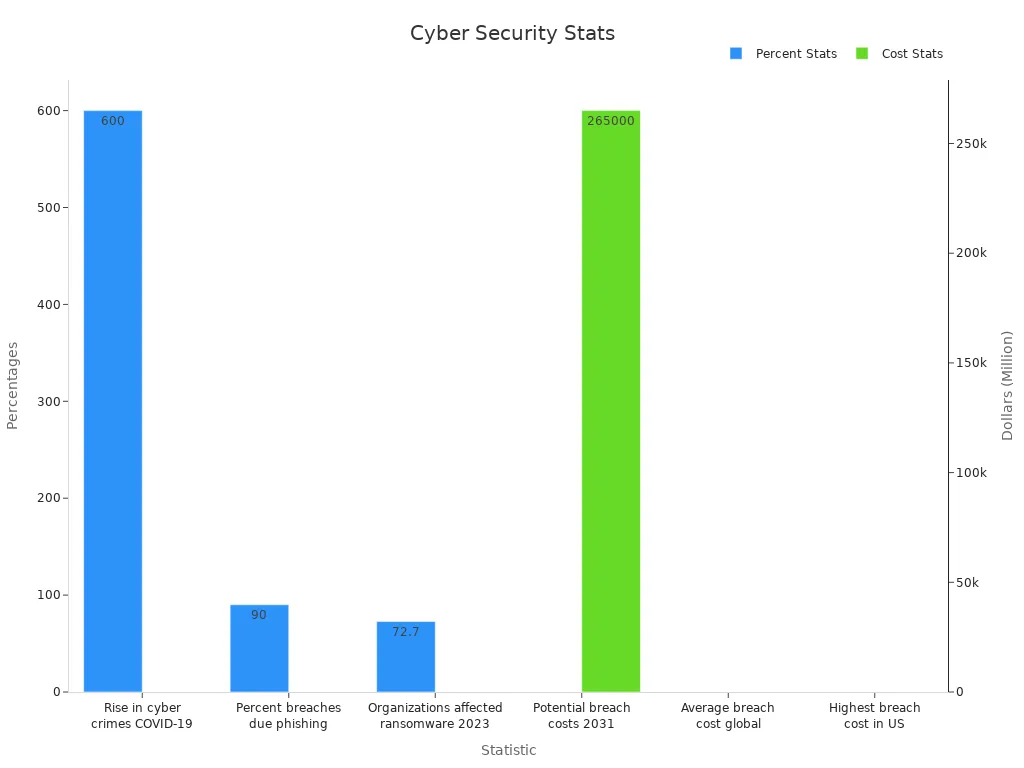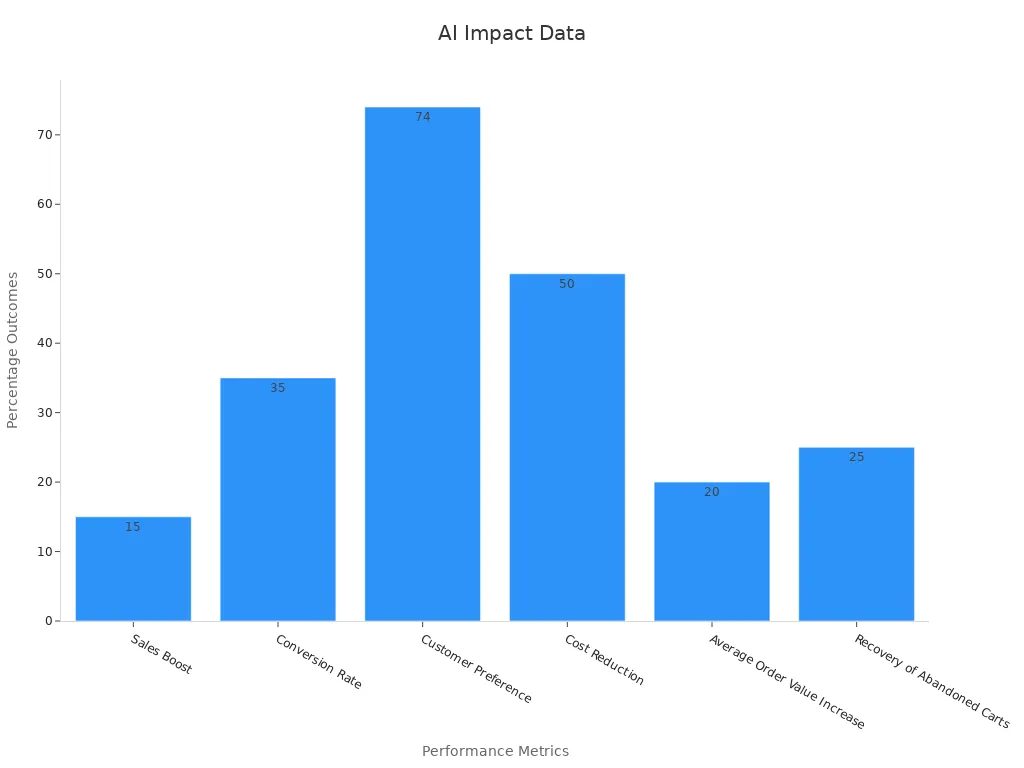Interactive Voice Recognition and Its Role in Modern Technology

Interactive voice recognition has revolutionized how you interact with businesses, making processes faster and more efficient. AI-powered voice assistants now handle up to 95% of customer interactions, significantly improving response times and reducing operational costs by as much as 68%. From voice search to intelligent assistants, this technology is shaping the future of customer service. Companies like Sobot are leading this change by integrating advanced IVR systems that deliver seamless, personalized experiences. With voice assistants becoming central to daily life, the future promises even smarter technologies to enhance efficiency and satisfaction.
Understanding Interactive Voice Recognition
Defining Interactive Voice Recognition
Interactive voice recognition is a technology that allows machines to understand and respond to spoken language. It combines advanced voice recognition technology with artificial intelligence to create systems that can interact with users in real-time. These systems, often referred to as IVR, are designed to handle tasks like voice search, customer inquiries, and even complex problem-solving.
To measure the effectiveness of interactive voice recognition, several key metrics are used. These include:
| Metric Type | Description |
|---|---|
| System stability metrics | Metrics such as uptime and latency that measure the reliability of the IVR system. |
| Question recognition metrics | Metrics like true positive rate that assess how accurately the system recognizes user queries. |
| Customer experience metrics | Metrics such as customer satisfaction percentage that evaluate the overall user experience. |
| Containment metrics | Metrics like First Call Resolution that measure the effectiveness of the IVR in resolving issues. |
| Activation metrics | Metrics such as signup percentage that track user engagement and system effectiveness. |
These metrics ensure that IVR systems deliver reliable and efficient service.
The Evolution of IVR Technology
IVR technology has come a long way since its inception. Early systems relied on manual code writing, which made them costly and difficult to maintain. The introduction of widget-based development simplified the process, allowing non-technical users to design IVR systems. Today, AI-powered automation has transformed IVR into a dynamic tool. It adapts to user inputs, providing personalized and efficient interactions.
For example, modern IVR systems use voice assistants to guide users through tasks like voice search or account management. This evolution has made IVR more accessible and effective for businesses and customers alike.
Why IVR Matters in Customer Contact Solutions
IVR plays a crucial role in improving customer contact solutions. It handles high-traffic queries, such as order status checks, banking transactions, and healthcare appointments. This reduces the workload on human agents and ensures faster service for customers.
However, not all users find IVR systems perfect. While 19% of users appreciate the time savings, 24% express frustration with navigation. Additionally, 57% prefer using a keypad over voice recognition due to accuracy concerns. Despite these challenges, IVR remains essential. It offers cost savings for businesses and provides a bypass option for users who prefer speaking with a live agent.
By integrating IVR with voice assistants, businesses can create a seamless experience. These systems not only improve efficiency but also enhance customer satisfaction.
Latest Advancements in Interactive Voice Recognition

AI and Machine Learning in IVR
AI and machine learning have transformed IVR systems into intelligent tools that adapt to your needs. These technologies analyze voice data in real-time, enabling systems to respond quickly and accurately. For example, AI-powered IVR systems can identify patterns in customer conversations, predict your needs, and provide customized feedback. This capability ensures that your interactions align with your expectations.
Telecom companies have already seen measurable improvements. AI integration has reduced call volumes and increased first-call resolution rates. These systems also enhance personalization, making your experience smoother and more satisfying. With AI voice search and conversational AI, IVR systems now deliver faster responses and better service quality.
Sobot’s AI solutions for retail and e-commerce demonstrate the power of AI in IVR. By automating repetitive tasks and providing real-time insights, these solutions improve operational efficiency and customer satisfaction.
Natural Language Processing (NLP) Enhancements
Natural language processing advancements have made IVR systems more conversational and intuitive. Modern systems now understand open-ended questions, allowing you to interact naturally without relying on keypad inputs. Enhanced caller verification methods have improved identification rates by over 20%, ensuring secure and efficient service.
These advancements also reduce costs. Businesses save thousands of dollars monthly by shifting calls to self-service options powered by NLP. Data collection and preprocessing further refine the system’s understanding, while future enhancements like emotion recognition promise even better contextual understanding.
Sobot’s IVR systems leverage cutting-edge NLP capabilities to deliver seamless voice-based interactions. Whether you’re managing orders or seeking support, these systems provide accurate responses tailored to your needs.
Advanced Speech Recognition for Real-Time Applications
Advanced speech recognition technology enables IVR systems to process voice commands instantly. Real-time analytics provide insights into customer interactions, helping businesses improve service quality. By analyzing data as you speak, these systems make informed decisions that enhance satisfaction and loyalty.
Testing speech recognition capabilities ensures accuracy and reliability. Businesses use this data to train and fine-tune their systems, improving performance over time. Far-field voice recognition, a key advancement, allows systems to understand commands even in noisy environments.
Sobot’s voice assistant technology incorporates advanced speech recognition to deliver high-quality interactions. With features like real-time call monitoring and AI-driven insights, Sobot ensures your experience is efficient and personalized.
Deep Learning Models for Improved Accuracy
Deep learning models have revolutionized the accuracy of interactive voice recognition systems. By leveraging advanced techniques like Convolutional Neural Networks (CNNs) and Recurrent Neural Networks (RNNs), these systems now achieve remarkable precision. For instance, classification tests using CNNs have demonstrated recognition accuracies of 99.5%, 100%, and 96.9%. These results highlight how deep learning can identify subtle acoustic features in speech, ensuring more reliable interactions.
You might wonder how this impacts your daily experience. Deep learning advancements allow voice recognition systems to process your commands faster and with fewer errors. Whether you're using voice assistants for navigation or managing tasks through smart home devices, these models ensure seamless communication. Real-world applications, such as customer service platforms, showcase how these technologies enhance user experiences by providing accurate and responsive solutions.
The integration of Natural Language Processing (NLP) with deep learning has further transformed voice recognition. NLP enables systems to understand context and intent, making interactions feel more natural. For example, when you ask a voice assistant to "find the nearest coffee shop," it not only recognizes the words but also understands your intent to locate a nearby café. This combination of NLP and deep learning ensures that your requests are met with precision.
Far field voice recognition, another breakthrough, allows systems to capture your voice even in noisy environments or from a distance. This technology is particularly useful in smart homes, where devices like speakers and thermostats rely on accurate voice commands. By incorporating far field voice recognition, these systems can distinguish your voice from background noise, ensuring smooth operation.
Sobot integrates these advancements into its IVR systems, delivering exceptional accuracy and responsiveness. By using deep learning models, Sobot ensures that its voice recognition solutions meet the highest standards. Whether you're managing orders or seeking support, Sobot's technology provides a reliable and efficient experience.
Applications of IVR in Customer Contact and Beyond

Revolutionizing Call Centers and Customer Service
Interactive voice recognition has transformed call centers into hubs of efficiency and customer satisfaction. By automating routine tasks, IVR systems allow agents to focus on complex issues, improving the overall user experience. For example, when you call a customer service line, IVR can handle tasks like account verification or order tracking, reducing wait times and ensuring faster resolutions.
The global conversational IVR market, valued at $2.1 billion in 2023, is expected to grow at a CAGR of 20% from 2024 to 2030. This growth reflects the increasing adoption of AI and consumer demand for faster service. By 2025, over 70% of businesses are projected to use conversational AI to enhance customer service efficiency. Additionally, advancements in AI, machine learning, and natural language processing have made IVR systems more intuitive and capable of understanding your needs.
Sobot’s IVR solutions exemplify this transformation. With features like drag-and-drop IVR design and AI-driven call routing, Sobot enables businesses to deliver seamless, personalized interactions. These tools not only improve operational efficiency but also enhance customer satisfaction, making them indispensable in modern call centers.
IVR in Healthcare for Patient Support
In healthcare, IVR systems play a vital role in improving patient support and care delivery. These systems provide automated reminders for appointments, medication adherence, and follow-ups, ensuring you stay on track with your health goals. For instance, an IVR system can call you to remind you about an upcoming doctor’s visit or refill a prescription.
Studies highlight the effectiveness of IVR in healthcare. One study showed increased medication adherence and reduced blood pressure among participants who received weekly IVR reminders. Another study found that personalized medication reminders and refill requests improved patient compliance. These findings demonstrate how IVR systems enhance healthcare outcomes by providing timely and accurate support.
Sobot’s voice assistant technology is well-suited for healthcare applications. With multilingual support and real-time speech recognition, Sobot ensures that patients receive clear and accurate information. Whether you need a reminder for your next appointment or assistance with medication management, Sobot’s IVR solutions make healthcare more accessible and efficient.
| Study Focus | Findings | Metrics Used |
|---|---|---|
| Medication adherence and refill compliance | Increased adherence and decreased blood pressure | Weekly reporting of medication adherence, side effects, and blood pressure readings |
| Feasibility and acceptability of IVR system | Personalized medication reminders and voice recognition features | Daily medication reminders and refill requests made three days prior to prescription end dates |
Smart Homes and IoT Integration
IVR systems are also revolutionizing smart homes and IoT devices. Imagine controlling your home’s lighting, temperature, or security system using just your voice. With advancements in far field voice recognition, IVR systems can understand your commands even from a distance or in noisy environments. This technology ensures that your smart home devices respond accurately, enhancing convenience and efficiency.
For example, when you say, “Turn off the lights in the living room,” your smart home system processes the command instantly. Far field voice recognition enables devices to distinguish your voice from background noise, ensuring seamless operation. This capability is particularly useful in homes with multiple occupants or active environments.
Sobot’s IVR solutions integrate seamlessly with IoT devices, offering features like real-time voice analytics and AI-driven insights. These tools make your interactions with smart home systems more intuitive and reliable. Whether you’re managing your home’s energy consumption or enhancing its security, Sobot’s technology ensures a smooth and efficient experience.
E-commerce and Personalized Customer Experiences
Interactive voice recognition (IVR) is transforming how you shop online. It enhances your experience by personalizing interactions and making processes more efficient. When you call an e-commerce platform, IVR systems can greet you by name, guide you through tailored menus, and even recommend products based on your purchase history. These features create a shopping experience that feels uniquely yours.
How IVR Enhances Your E-commerce Journey
IVR systems in e-commerce focus on making your interactions smoother and more engaging. Here’s how they achieve this:
- Customizable greetings based on your caller data make you feel valued.
- Intelligent call routing connects you to the right department quickly, reducing wait times.
- Personalized menus tailored to your shopping history help you find what you need faster.
Surveys show that 90% of customers appreciate personalized interactions, highlighting how IVR fosters emotional connections with brands.
Features That Improve Your Experience
IVR systems offer several features that enhance your shopping journey:
- Simple and clear menus make navigation easier for you.
- Self-service options let you track orders or check delivery status without waiting for an agent.
- Integration with other channels ensures a seamless omnichannel experience.
- AI-powered personalization adapts to your preferences, making interactions smarter and more dynamic.
For example, an e-commerce platform implemented an IVR system that allowed you to track orders and receive personalized product recommendations. By connecting the IVR to its customer database, the platform tailored interactions to your needs. This approach improved customer retention and satisfaction significantly.
Why Personalization Matters
Personalization isn’t just about convenience; it’s about creating a connection. When an IVR system remembers your preferences or suggests products you might like, it shows that the brand understands you. This builds trust and loyalty, making you more likely to return for future purchases.
| Feature | Benefit to You | Example Use Case |
|---|---|---|
| Customizable Greetings | Makes you feel valued | Greeting you by name when you call |
| Intelligent Call Routing | Saves your time | Connecting you to the right department |
| Personalized Menus | Streamlines your experience | Showing options based on your history |
| AI Integration | Offers smarter interactions | Recommending products you’ll love |
IVR systems in e-commerce aren’t just tools; they’re your personal shopping assistants. By combining advanced technology with customer data, they create experiences that feel tailored to you.
Emerging Trends in Interactive Voice Recognition
Emotional Intelligence in Voice Assistants
Voice assistants are becoming smarter, but their ability to understand emotions is what sets them apart. Emotional intelligence in voice assistants allows them to detect your mood and respond appropriately. For example, if you sound frustrated, the assistant might offer a calming tone or suggest solutions to ease your concerns. This capability enhances personalization and builds trust.
A study highlights how emotional attachment influences your willingness to share information with voice assistants. It shows that emotionally intelligent systems can balance personalization with privacy, ensuring you feel comfortable while interacting. These advancements make voice assistants more effective and respectful of your needs.
Multimodal Interactions Combining Voice and Visuals
Multimodal interactions combine voice commands with visual elements, creating richer and more engaging experiences. Imagine asking a voice assistant for weather updates and seeing a detailed forecast on your screen. This integration makes information easier to understand and act upon.
| Field | Example | Effectiveness Description |
|---|---|---|
| Healthcare | Combining medical imaging with patient history text | Leads to more accurate diagnoses and enhances decision-making through comprehensive data analysis. |
| Education | AI tutors using speech, text, and visuals | Provides engaging instruction and personalized feedback, catering to different learning styles. |
| Customer Support | AI chatbots understanding text and voice inputs | Elevates customer interaction by analyzing emotional cues and providing a comprehensive understanding of feedback. |
| Entertainment | Multimodal LLMs generating image captions | Enhances creative potential and improves content indexing and searchability through insightful descriptions. |
These interactions are transforming industries like healthcare, education, and entertainment. They make technology more intuitive and accessible, helping you achieve better outcomes in various scenarios.
Enhanced Security with Voice Biometrics
Voice biometrics add a layer of security to IVR systems by verifying your identity through unique voice patterns. This technology reduces the risk of fraud and ensures safe interactions. For instance, when you access your bank account via an IVR system, voice biometrics confirm your identity without requiring passwords.
The rise in cyber crimes during COVID-19 underscores the importance of robust security measures. Statistics reveal that phishing accounts for 90% of breaches, while ransomware affects 72.7% of organizations globally. Voice biometrics address these challenges by offering secure and convenient authentication methods.

Sobot integrates voice biometrics into its IVR systems, ensuring your data remains protected. These advancements not only enhance security but also improve user experience by making authentication seamless and reliable.
IVR’s Role in the Future of Omnichannel Customer Engagement
Interactive voice recognition (IVR) is shaping the future of customer engagement by connecting multiple channels into a unified experience. When you interact with a business, you expect seamless transitions between platforms like phone calls, live chat, and social media. IVR systems make this possible by integrating advanced technologies such as artificial intelligence and natural language processing. These tools enable predictive support and personalized responses, ensuring your experience feels smooth and tailored.
IVR systems also enhance customer engagement through interactive surveys. They streamline survey delivery, improve data accuracy, and provide real-time analytics. For example, when you complete a survey after a call, the system can instantly analyze your feedback and adjust its approach to better meet your needs. Multi-language options extend this capability globally, allowing businesses to connect with diverse audiences.
The future of voice assistants relies heavily on IVR systems. These assistants will become smarter, offering self-service features that let you access information quickly. For instance, you might use a voice assistant to check your account balance or schedule an appointment without waiting for a live agent. This automation saves time and improves your overall experience.
Market trends show that IVR systems are becoming essential for businesses. The global IVR market is projected to grow from USD 5.56 billion in 2024 to USD 9.26 billion by 2031. This growth reflects the increasing demand for cost savings and operational efficiency. Businesses benefit from automated inquiry processing, while you enjoy faster and more reliable service.
IVR systems are not just tools; they are the backbone of omnichannel customer engagement. By integrating voice assistants, surveys, and analytics, they create a future where your interactions are smarter, faster, and more personalized.
Sobot’s Role in Advancing IVR Technology
How Sobot’s Voice for Sales Enhances Customer Interactions

Sobot’s Voice for Sales platform revolutionizes how businesses interact with customers. It simplifies telesales by automating repetitive tasks and providing real-time insights. With features like automatic dialing and AI-driven call monitoring, this platform ensures that your interactions are efficient and personalized. For example, it uses global phone number coverage and local caller IDs to improve connection rates, making it easier for businesses to reach you wherever you are.
“By leveraging LLMs instead of keywords, our Thinking Machine prompts customers to speak conversationally, increasing the amount of data collected.” This approach transforms customer interactions, creating a virtuous cycle of improved data and better service.
Sobot’s Voice for Sales also integrates seamlessly with popular CRM systems like Salesforce and HubSpot. This integration allows businesses to manage customer data effectively, ensuring that your experience feels tailored and responsive. With its AI capabilities, the platform not only enhances productivity but also builds trust and satisfaction.
Sobot’s AI Solutions for Retail and E-Commerce
Sobot’s AI solutions empower retail and e-commerce businesses to deliver exceptional customer experiences. These solutions use conversational AI to handle inquiries, recommend products, and recover abandoned carts. For instance, Alibaba Group saw a 35% conversion lift and a 20% increase in average order value by adopting AI-driven strategies.
| Metric | Evidence/Outcome |
|---|---|
| Sales Boost | H&M recorded a 15% increase in sales |
| Conversion Rate | Alibaba Group saw a 35% conversion lift |
| Customer Preference | 74% of customers prefer chatbots over human interaction |
| Cost Reduction | Up to 50% reduction in customer acquisition costs |
| Average Order Value Increase | Alibaba experienced a 20% jump in AOV |
| Recovery of Abandoned Carts | Up to 25% success in recovering abandoned carts |
Sobot’s AI solutions also ensure compliance with data privacy regulations, giving you peace of mind while interacting with businesses. By integrating AI voice search and voice assistant technology, these solutions make your shopping journey seamless and enjoyable.

Case Study: Weee! and Sobot’s Flexible IVR System
Weee!, America’s largest online Asian supermarket, partnered with Sobot to overcome challenges like inflexible IVR systems and language barriers. Sobot implemented a flexible IVR system with intelligent call routing and multilingual support. This system allowed Weee! to serve its diverse customer base more effectively.
The results were remarkable. Agent efficiency increased by 20%, and resolution time dropped by 50%. Customer satisfaction soared to 96%. These improvements highlight how Sobot’s IVR technology can transform customer service operations, ensuring that you receive timely and accurate support.
The Future of Interactive Voice Recognition
Predictions for IVR in 2025 and Beyond
The future of interactive voice recognition (IVR) promises groundbreaking advancements that will redefine how you interact with technology. By 2025, the global adoption of IVR systems is expected to reach 75% among businesses, with public sector use cases expanding to 50%. This growth reflects the increasing reliance on AI-powered solutions to streamline communication and enhance user experience.
Several trends are shaping this future. The rise in smartphone users, projected to hit 7.2 billion by 2025, will drive demand for IVR systems. Cloud-based IVR platforms are gaining popularity due to their scalability and real-time analytics. Additionally, the integration of Natural Language Understanding (NLU) will enable IVR systems to anticipate your needs and provide tailored services.
| Metric | Value | Source |
|---|---|---|
| Global AI Speech Translation Market | $5.73 billion by 2028 | The Business Research Company |
| Adoption by Businesses | 75% by end of 2025 | N/A |
| Voice Commerce Value | $57 billion globally by 2025 | Juniper Research |
These advancements will make IVR systems more intuitive, efficient, and accessible, ensuring they remain integral to the future of voice assistants and AI voice search.
The Role of IVR in Shaping Customer Engagement Strategies
IVR systems are transforming customer engagement by enabling personalized and efficient interactions. Businesses now use voice analytics to gain insights from customer conversations, making your interactions more meaningful. For example, IVR systems can analyze caller behavior to refine service delivery and improve productivity.
| Aspect | Description |
|---|---|
| Personalization | IVR technology enables tailored experiences for customers, enhancing their engagement. |
| Real-time Feedback | Immediate responses through IVR provide customers with timely assistance, improving satisfaction. |
| Data Analytics | Analyzing caller behavior through IVR helps refine service delivery and scripts for better outcomes. |
The future of voice assistants relies heavily on IVR systems. These systems integrate seamlessly with other channels, creating a unified experience. For instance, Sobot’s IVR solutions use AI to deliver real-time feedback and personalized interactions, ensuring your needs are met efficiently. This approach not only enhances customer satisfaction but also builds trust and loyalty.
How Advanced Speech Recognition Will Transform Industries
Advanced speech recognition is revolutionizing industries by improving efficiency and reducing costs. In banking, voice-activated solutions enhance security through biometric recognition. Retailers use voice search technology to simplify shopping, while healthcare providers rely on voice assistants to manage patient records securely.
- Banking and Finance: Voice biometrics improve customer support and security.
- Retail and E-commerce: Voice search simplifies product discovery.
- Healthcare: Clinicians use voice technology for efficient record management.
- Transportation: Voice-assisted booking systems enhance customer experience.
The integration of AI, machine learning, and natural language processing is driving these transformations. For example, Sobot’s AI-powered IVR systems leverage advanced speech recognition to deliver accurate and responsive solutions. Whether you’re shopping online or managing healthcare appointments, these systems ensure a seamless user experience.
Interactive voice recognition (IVR) continues to redefine how you interact with businesses. Advancements like AI and machine learning personalize your experience and streamline resolutions. Natural language processing (NLP) enhances understanding, while integration with other technologies ensures seamless transitions across channels.
| Advancement/Trend | Description |
|---|---|
| AI and Machine Learning in IVR | Enhances user experience by personalizing customer journeys and streamlining resolution processes. |
| Natural Language Processing (NLP) | Improves understanding of caller needs, allowing for real-time relevant responses. |
| Integration with Other Technologies | Facilitates seamless transitions between different customer support channels for a better experience. |
IVR plays a pivotal role in improving customer service and operational efficiency. It reduces wait times, automates routine tasks, and delivers personalized support. As Sobot integrates cutting-edge AI into its IVR systems, you can expect smarter solutions that adapt to your needs. The future of IVR promises even greater innovation, ensuring technology continues to enhance your interactions and satisfaction.
FAQ
What is Interactive Voice Recognition (IVR)?
Interactive Voice Recognition (IVR) is a technology that allows machines to understand and respond to spoken language. It uses artificial intelligence and voice recognition to interact with users in real-time, handling tasks like customer inquiries, voice search, and automated support.
How does IVR improve customer service?
IVR improves customer service by automating routine tasks, reducing wait times, and providing personalized support. It routes calls to the right department and offers self-service options, ensuring faster resolutions and a better experience for you.
Can IVR systems understand multiple languages?
Yes, modern IVR systems support multiple languages. They use advanced natural language processing (NLP) to recognize and respond to different languages, making them suitable for global businesses and diverse customer bases.
Is IVR secure for sensitive information?
Absolutely! IVR systems often include voice biometrics and encryption to protect your data. These features ensure secure authentication and reduce the risk of fraud during interactions.
How does Sobot enhance IVR technology?
Sobot enhances IVR technology with AI-driven features like real-time call monitoring, multilingual support, and intelligent call routing. These innovations improve efficiency and ensure personalized, seamless interactions tailored to your needs.
See Also
Understanding The Functionality Of IVR Voice Recognition
Key Features Of Interactive Voice Response Software
Comparative Analysis Of Leading Interactive Voice Response Solutions
